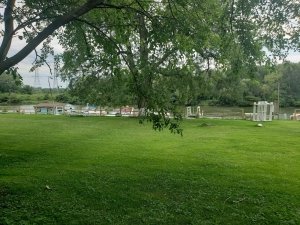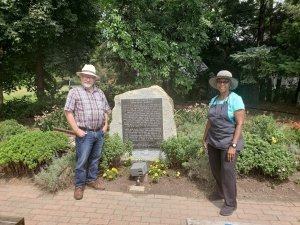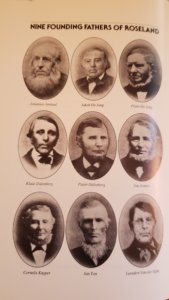 This past fall was to be my 45th high school reunion (yes, FORTY-FIFTH, I know, I’m old). We also learned last summer that the re-dedication celebration of the memorial in honor of my great-great-grandparents was to be held the very same day.
This past fall was to be my 45th high school reunion (yes, FORTY-FIFTH, I know, I’m old). We also learned last summer that the re-dedication celebration of the memorial in honor of my great-great-grandparents was to be held the very same day.
Let the wrestling match in my head begin…
…attend the reunion and see friends I had not seen in five years (or 45 years) …
…attend a celebration in Chicago with people we did not know…
…spend three days in Evansville attending dinners and lunches…
…drive to a celebration we knew little about…
…my high school days were far from my glory days (queue Bruce Springsteen) …
…being a direct descendant of the honorees would make us mini-celebrities…
…I was a shy, quiet, nerd in high school (I know, hard to believe, right?) …
…we would undoubtedly learn more about our family history…
…it would be a chance to see Hal, Beth, Tim, Kim, Jim, Harold, and others…
…besides, we’d already paid for the reunion…
…Chicago is a long way to go for an hour ceremony…
I chose the reunion.
A Funny thing happened on the way…to the reunion
As summer turned to fall, I’d be lying if I said I didn’t think about the decision a time or two (or, three), but did not waiver. Just after Labor Day, I received a message from a buddy of mine from high school. He needed to talk to me about something, could I jump on a call? Of course! Hal was one of those high school friends that I had reconnected with over the last decade. He and his wife, Beth (who I knew from church youth group as a kid) are one of the couples Carmen and I make a point to stay in touch with and to see them when we can. They have both had health scares since our last reunion five years ago. I dreaded the news he was likely to share.
As it turned out, Hal wanted to talk about the reunion. He was one of our class officers and has been involved in planning each reunion. Boy, was I relieved?!!? His news? It seems the planning committee had reached an impasse on masks/no masks, vaccines/no vaccines related to the pandemic. Rather than push the issue and cause hard feelings, the reunion was being canceled! No offense to Hal nor any of the other committee members, but I almost cheered. We immediately started making plans to attend the re-dedication celebration in South Holland.
A Funny thing happened on our way…to the re-dedication
I don’t recall when Carmen and I got the bug for tromping through cemeteries, nor do I recall how many we have tromped through. We have visited the graves of ancestors, historical figures, and servicemen and women (known to us and not) across the U.S and in Europe. It only seemed fitting we should visit Jan and Aagje’s graves in Mount Greenwood on our way to a ceremony rededicating a monument to their honor.
The 16th of October found us heading up I-65 early enough to spend an hour or so investigating the graves, grab lunch, and make it to the church on time. It was a crisp autumn day, a great day for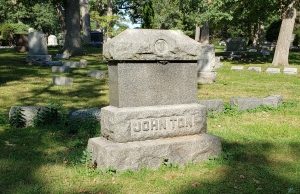 exploring a cemetery for graves of ancestors and pioneers. Locating the Ton area was easy-peasy (thanks to FindaGrave.com!). Many of the headstones had been updated since the original internment. Some, however, were old enough to render them unreadable. We decided to venture over to the Cemetery office to investigate the plot maps.
exploring a cemetery for graves of ancestors and pioneers. Locating the Ton area was easy-peasy (thanks to FindaGrave.com!). Many of the headstones had been updated since the original internment. Some, however, were old enough to render them unreadable. We decided to venture over to the Cemetery office to investigate the plot maps.
The woman in the office was incredibly helpful. She pulled out records from 125 years ago when Jan died and was buried. We reviewed plot maps (and wished we had stopped in before trying to make sense of the headstones, would have made THAT a lot easier!). We learned enough to know we would like to go back when we have more time. We’d love to dig into some of those old records. Jan’s record indicates he died at home from cancer of the perineum (if I am reading the handwriting properly).
We decided we wanted to take the time to place flowers on Jan and Aagje’s headstones, so we headed to a nearby florist. As we talked with the clerk, we learned the shop typically closed at noon. She just happened to be staying late to meet with someone who had not arrived yet to pick up an arrangement. As we were preparing to leave, she asked if we would mind staying. The person she was supposed to meet was from the “east side”. I remember thinking, isn’t the east side of Chicago a lake? A little perplexed, but assuming from her tone we knew the source of her uneasiness. Not knowing what else to do, we agreed to stay. A few minutes later our suspicions were confirmed as two men, two African American men, arrived to pick up an arrangement for their mother’s plot.
It was a non-event. They picked up their flowers. They chatted cordially, and they left.
The irony. We had driven several hours to pay our respects to and celebrate emigrants who risked jail, bodily harm, and deportation to aid fellow human beings as they sought their freedom, and the clerk was apprehensive about meeting two men from “the east side”. Over lunch, Carmen and I tried to focus on the ceremony ahead, but our minds kept returning to the clash of images separated by 150 years…
…was she being racist?
…was she being sensible and safe?
…as a woman, was she afraid to be alone with two men?
…was she afraid to be alone with them because they were from “the East Side”?
…was she afraid to be alone with them because she assumed they would be African American?
…she had no idea what reaction we would have, why did she even say anything?
…what should WE have done or said? We, ourselves, had been warned to be careful driving around Roseland because “it’s not a good area”.
Our lunch over, we headed to the Re-dedication Ceremony. We pushed the interaction out of our minds so we could be fully present at the celebration of the Memorial Garden.
The Re-dedication; a family reunion; and family extended
The memorial to Jan and Aagje is on the grounds of the First Reformed Church of South Holland. The site for the memorial was chosen because Jan had served as one of the first deacons of the church. We arrived a few minutes before the re-dedication was to begin. As soon as Carmen mentioned to the greeter that we were descendants of Jan and Aagje, we were promptly escorted into the downstairs meeting hall.
We were quickly introduced to Robin Scheldberg from the South Holland Historical Society. You may recall from my earlier ramblings; Robin had reached out to me after discovering one of my posts about Jan and Aagje. It was she that first told us about the rededication. Within moments we reunited with Nadine Harris Clark, the gardener extraordinaire who maintains the memorial gardens and who is also the aunt of LeRone Branch. You may recall from my earlier posts, LeRone was the Eagle Scout who led the effort to build the memorial.
We were both very anxious to meet LeRone. Personally, I wanted to shake his hand and thank him for honoring my great grandparents. Nadine shepherded us across the room in his direction. Before we reached LeRone, she stopped to introduce us to his Uncle Mike. Mike Cowan drafted the original design of the hardscape for the memorial and volunteers his time to help keep the gardens manicured.
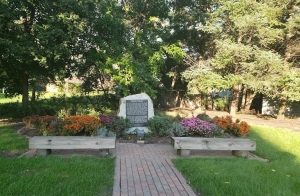 Mike’s design is breathtaking. A 9,000-pound piece of granite serves as the centerpiece. Railroad tracks run across the garden disappear under the granite and reappear on the other side to represent the Underground Railroad. Surrounding the stone is a garden of flowers and grasses that would have been native to the prairie south of Chicago 150 years ago. A brick walkway leads from the drive to the memorial. A pair of benches sit to either side so one can sit and soak it all in.
Mike’s design is breathtaking. A 9,000-pound piece of granite serves as the centerpiece. Railroad tracks run across the garden disappear under the granite and reappear on the other side to represent the Underground Railroad. Surrounding the stone is a garden of flowers and grasses that would have been native to the prairie south of Chicago 150 years ago. A brick walkway leads from the drive to the memorial. A pair of benches sit to either side so one can sit and soak it all in.
After thanking Mike for his efforts and his design, we stepped across the room to shake hands with the man of the hour, LeRone. LeRone is now in his mid-twenties and a tax accountant for one of the big four firms. Ten years ago, as an aspiring Eagle Scout, he chose this project as his Eagle Scout Service project to complete the requirements of the rank. Now, I have never met a real rock star before, but my heart was racing like I was getting ready to shake hands with Mick Jagger, Keith Richards, or Ronnie Wood! What an amazing undertaking it must have been for a kid of, what? sixteen!

LeRone Branch
It was an honor to shake his hand, thank him for memorializing Jan and Aagje, and chat with him for a few minutes. His project serves primarily as a reminder of the brave souls who escaped enslavement and sought freedom by traveling on foot, by boat, sometimes by train. Many times, their ultimate destination was Canada. As historian Larry McClellan states, “to find freedom, they had to leave the land of the free”. Bravery is not the lack of fear, but rather the courage to act in the face of fear. As I view the memorial, yes, I think of Jan and Aagje, but more than those two ancestors, I think of the thousands of men, women, and children who traveled in, not just fear, but terror, towards freedom and a better life.
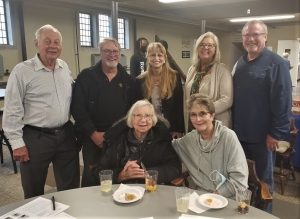
Eenigenburg – Ton Reunion
After chatting with LeRone, we made our way over to one of the display tables. It was covered with Ton family history pieces, most of which we had not seen before. We soon learned the pieces were from the collection of the keynote speaker, Merritt Bethig. Merritt is a descendant of my great-great-grandfather, Jan Ton of Holland (The Netherlands). Jan’s daughter Jannetje was my great-grandfather Jan’s sister. She married Gerrit Eenigenburg and emigrated to the U.S. on the same ship as Jan and Aagje. We soon learned there were many Eenigenburgs in attendance. We had a great time having a mini–Ton Family reunion. We met Merritt, of course, and his sister Jean Bristow. We also met Marie Eenigenburg Min and her cousin Bob Eenigenburg.
Moments before the program was to begin Nadine approached me. Somewhat nervously she asked if I would be willing to say a few words during the program. With a quick glance at Carmen, I smiled and said, “absolutely, I would be honored”. As Nadine walked away, I turned to Carmen and said with a chuckle, “now…to think about what I am going to say…”.
The Program – the distant past; the not-so-distant past; and the future
Nadine quieted the crowd and thanked everyone for attending the rededication ceremony. She asked LeRone to come and sit in one of the chairs sitting in the front of the room. Somewhat shyly, and perhaps a little embarrassed with all the attention, he took his place.
Pastor Jim Oord of the First Reformed Church welcomed us to the church. He told a short story of Jan bringing firewood to the first pastors of the church to help keep them (and the church warm). The image of Jan, with his wagon full of wood, riding across the prairie to the church served as another piece of the puzzle forming the picture of Jan and Aagje.
Special recognition was given to Anthony Volek of Volek Brothers Construction, Anthony was one of LeRone’s Scout Masters. Not only did he provide leadership, but he had access to the heavy equipment needed to build the hardscape, including moving the 9,000-pound boulder from the quarry to the site. Amazing what a team of Scouts can do in a day…with some great leaders and the right equipment!
The next speaker was Bill Paarlberg Past President of the South Holland Historical Society, it was his suggestion to honor Jan and Aagje in this way that led to the entire project. The Historical Society has a great collection of materials that tell the story of the area from the early 1800s through today. You can bet Carmen and I will be diving deep into these materials!
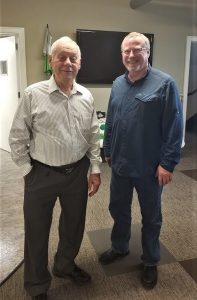
Merritt Bethig
For his keynote presentation, Merritt Bethig focused on the trip from The Netherlands, to France, to New York, and ultimately, to High and Low Prairie south of Chicago (today’s Roseland and South Holland). The Hollanders, as they came to be called, consisted of 65 men, women, and children who left their homeland and headed to America in 1849. Not long into the journey, the ship was besieged with cholera. 17 of the Hollanders died. One can only imagine the filth, the smells, the vermin, and the death that made the journey intolerable.
From New York, they traveled the Hudson River to the Erie Canal. After traversing the Canal, they boarded another ship to navigate the Great Lakes, arriving at the port of Chicago 60 some-odd days since leaving their homeland. Upon arriving in Chicago, they met up with some Hollanders who had preceded them and settled about 20 miles south in the prairie lands near the Little Calumet River. Given the low-lying marshy lands in the area, it must have felt a bit like home.
Much of Merritt’s talk was based on the book by another Ton relative, Jill Eenigenburg. Her book, From Tulipland to Roseland and Back, tells the story of the Eenigenburg family and the creation of a museum in the village of Eenigenburg, The Netherlands. The Tons and the Eenigenburgs have been intertwined for over 170 years!
After the keynote, Nadine turned to me and asked me to speak. My first instinct was to walk across the front of the room to LeRone, shake his hand, and thank him for honoring my ancestors. I then spoke for a few minutes about our “discovery” of the story of Jan and Aagje and our trip to the area the previous summer.
Tom Sheppard took up the story and shared about the Tons’ involvement in the Underground Railroad. Tom is one of the founders of the Little Calumet River Underground Railroad Project. He provided an update on the project including a canoe trail on the Little Calumet and signage to be placed in several spots in the area, including at the site of Jan and Aagje’s farm.
It was now time to hear from the man of the hour, LeRone Branch himself. When Bill Paarlberg suggested the idea of a memorial to the Underground Railroad and Jan and Aagje Ton, LeRone pictured a plaque on a pole. Pretty simple, right? A plaque on a pole…until Uncle Mike got ahold of the idea! LeRone’s vision of a plaque on a pole turned into quite a project! LeRone graciously thanked all those involved in the original project, as well as those responsible for the rededication ceremony itself.
The final speaker of the day was Nadine herself. She talked about the plant selection for the gardens and the group of volunteers that maintain them. The group researched the types of plants that would have been native to the Great Lakes Region at the time. They continue to research and as they learn more, they update the garden.
After the program, there was time to view the exhibits, chat with new friends, and snap a picture or two (or three or four). A group of us then walked out to the memorial. It had changed. It had taken on new meanings. The words from the program echoed in our heads and hearts. Here we were surrounded by family…cousins who had never met. Here we were surrounded by new friends…Nadine, her sisters, LeRone, Uncle Mike…new friends that now felt like family.
How I wish the clerk at the florist could have joined us that day. How I wish she could have felt what we felt that day. How I wish…
===============================================================
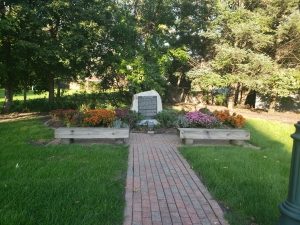
I know this was a long post. Thank you for sticking with me through the story! Before I wrap things up, I want to name some names, as a way of thanking THEM for the work they have done.
Development of the Memorial Garden
Garden Construction: July 9, 2011
Initial Planting: August 10, 2011
Dedication: October 15, 2011
- South Holland Historical Society and Bill Paarlberg (initiated project)
- Boy Scout Troop 409 and Scoutmasters Mark Cipich and Anthony Volek
- South Holland Garden Club
- Larry McClellan and Paul Petraitis, Historians
- Paul Ton, Original Working Committee
- Rochelle Harris Branch (LeRone’s Mother), Original Working Committee
- Yolanda Harris, Original Working Committee
- Pastor Mel DeVries, First Reformed Church and Original Working Committee (Deceased)
- Richard Zimmerman, First Reformed Church, and Original Working Committee.
- Robin Scheldberg, President, South Holland Historical Society, and President, South Holland Garden Club
- Lynn Larsen, South Holland Historical Society, South Holland Garden Club, and Original Working Committee
- Nadine Harris Clark Garden Coach
- Mike Cowan, drafted the original design of the hardscape and currently helps maintain the garden
Rededication Ceremony
- Nadine Harris Clark
- Robin Scheldberg
- Richard Zimmerman
- Pastor Jim Oord, First Reformed Church of South Holland
- The Congregation of the First Reformed Church of South Holland
- Weed and Feed Club (Charlie and Rich)
- South Holland Garden Club
- South Holland Historical Society
A special, heartfelt thanks to LeRone Branch and Nadine Harris Clark, truly a part of our family.
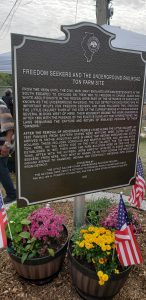 Hallowed Ground…I could not shake that thought from my mind. Hallowed Ground. We were standing on hallowed ground. The thought brought back memories of my childhood growing up in the church…the old gospel hymn “Standing on Holy Ground,”…the many scriptures that spoke of removing your sandals to stand on holy ground…that day, we indeed were standing on hallowed ground…sacred…revered…not because it had been consecrated and declared as such, but because of what happened there…between strangers from different lives and different worlds.
Hallowed Ground…I could not shake that thought from my mind. Hallowed Ground. We were standing on hallowed ground. The thought brought back memories of my childhood growing up in the church…the old gospel hymn “Standing on Holy Ground,”…the many scriptures that spoke of removing your sandals to stand on holy ground…that day, we indeed were standing on hallowed ground…sacred…revered…not because it had been consecrated and declared as such, but because of what happened there…between strangers from different lives and different worlds. 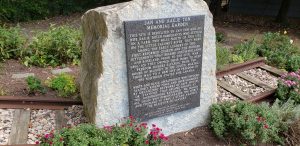
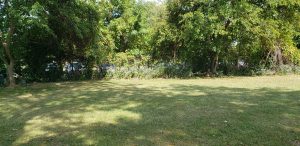 As I walked through the grass to where the house would have been located, the emotions came alive. It was here freedom seekers would come, seeking safety, protection, food, warmth, and transportation for the next leg of their long journey. It was here Jan and Aagje would risk fines, jail time, or worse.
As I walked through the grass to where the house would have been located, the emotions came alive. It was here freedom seekers would come, seeking safety, protection, food, warmth, and transportation for the next leg of their long journey. It was here Jan and Aagje would risk fines, jail time, or worse. 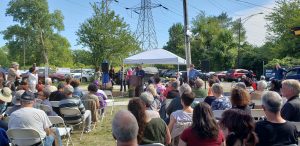


 This past fall was to be my 45th high school reunion (yes, FORTY-FIFTH, I know, I’m old). We also learned last summer that the re-dedication celebration of the memorial in honor of my great-great-grandparents was to be held the very same day.
This past fall was to be my 45th high school reunion (yes, FORTY-FIFTH, I know, I’m old). We also learned last summer that the re-dedication celebration of the memorial in honor of my great-great-grandparents was to be held the very same day. exploring a cemetery for graves of ancestors and pioneers. Locating the Ton area was easy-peasy (thanks to FindaGrave.com!). Many of the headstones had been updated since the original internment. Some, however, were old enough to render them unreadable. We decided to venture over to the Cemetery office to investigate the plot maps.
exploring a cemetery for graves of ancestors and pioneers. Locating the Ton area was easy-peasy (thanks to FindaGrave.com!). Many of the headstones had been updated since the original internment. Some, however, were old enough to render them unreadable. We decided to venture over to the Cemetery office to investigate the plot maps. Mike’s design is breathtaking. A 9,000-pound piece of granite serves as the centerpiece. Railroad tracks run across the garden disappear under the granite and reappear on the other side to represent the Underground Railroad. Surrounding the stone is a garden of flowers and grasses that would have been native to the prairie south of Chicago 150 years ago. A brick walkway leads from the drive to the memorial. A pair of benches sit to either side so one can sit and soak it all in.
Mike’s design is breathtaking. A 9,000-pound piece of granite serves as the centerpiece. Railroad tracks run across the garden disappear under the granite and reappear on the other side to represent the Underground Railroad. Surrounding the stone is a garden of flowers and grasses that would have been native to the prairie south of Chicago 150 years ago. A brick walkway leads from the drive to the memorial. A pair of benches sit to either side so one can sit and soak it all in.



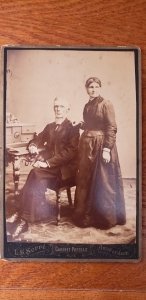

 Larry soon arrived, followed shortly thereafter by Duane and June. Let the reunion commence! Larry has been researching the history of the area, the Tons, and the Underground Railroad for years. He has written numerous articles and books on the subject. We stood near the monument while he shared the history with us. He believes between four and five hundred Freedom Seekers passed through this area on their way to Canada. “They had to leave the land of the free, to become free”, he stated.
Larry soon arrived, followed shortly thereafter by Duane and June. Let the reunion commence! Larry has been researching the history of the area, the Tons, and the Underground Railroad for years. He has written numerous articles and books on the subject. We stood near the monument while he shared the history with us. He believes between four and five hundred Freedom Seekers passed through this area on their way to Canada. “They had to leave the land of the free, to become free”, he stated. 